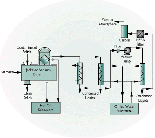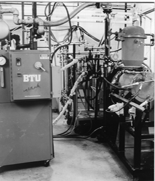


The U.S. Department of Energy facility operated by Rust Geotech Inc. in Grand Junction, Colorado is building a large-scale VAC*TRAX vacuum dryer unit for testing by mid-1996. The VAC*TRAX technology was developed by Rust Federal Services Inc. at the Clemson Technical Center in South Carolina under a 1992 Program Research and Development Announcement issued by the DOE Office of Science and Technology.
 VAC*TRAX separates contaminants such as semivolatile and volatile organic compounds, polychlorinated biphenyls, and radioactive materials from soils, sludges, and solid trash. The products of the VAC*TRAX treatment are then ready for further treatment or disposal. The system is still in the demonstration stage. Several pilot tests using small-scale units have been successfully performed at DOE sites, such as the Rocky Flats Environmental Technology Site.
VAC*TRAX separates contaminants such as semivolatile and volatile organic compounds, polychlorinated biphenyls, and radioactive materials from soils, sludges, and solid trash. The products of the VAC*TRAX treatment are then ready for further treatment or disposal. The system is still in the demonstration stage. Several pilot tests using small-scale units have been successfully performed at DOE sites, such as the Rocky Flats Environmental Technology Site.
VAC*TRAX is based on Rust's patented X*TRAX technology, which separates organic contaminants from solids like soil by heating them in a dryer at approximately 120 degrees Celsius. VAC*TRAX is different in that it is a vacuum dryer. By sealing the drying chamber and reducing the air pressure, a vacuum is created. The vacuum allows a much lower temperature to be used in the dryer, enabling the use of smaller, more transportable equipment.
The full-scale VAC*TRAX vacuum dryer unit will consist of two trailers and is designed for easy transport and setup. When in place, the system will only require an electrical power source, a propane or natural gas fuel source, a nitrogen source, and any housekeeping pads or facilities required by the site. The full-scale unit will be capable of treating approximately ten cubic yards of mixed waste at a time.
![]()
VAC*TRAX heats contaminated waste to the point at which the contaminants separate from the solids. Solid wastes, such as soil or contaminated work clothing, are placed in the dryer first. In order to prevent combustible waste from burning, nitrogen, which is nonflammable, is pumped into the dryer, replacing the oxygen and other flammable gases. Heat is applied for one or two hours, then the vacuum is applied. The length of time the vacuum is applied depends on the type and amount of waste being treated.
As the waste is heated, the contaminants become gas. The nitrogen forces the gases through a filtered outlet, safely trapping any solid particles such as dust within the dryer chamber. The gas then passes through a series of condensers that cool the gas in three stages until it becomes liquid. The condensed liquid is collected in a trap and removed for off-site disposal.
Most of the remaining nitrogen used to push the contaminants through the system is recirculated into the dryer. A small amount is filtered and released to prevent oxygen build-up in the dryer. Before it is released into the environment, the nitrogen is passed through a High-Efficiency Particulate Air filter to remove solid particles. Finally, the nitrogen passes through a carbon adsorption canister to remove volatile organic compounds. This filtering prevents any radioactive emissions.
The solids left in the dryer are chemically inactive. The vacuum is released, a sealed door in the bottom of the dryer is opened, and the solid waste is dropped into a container under the dryer. VAC*TRAX is then ready to begin treating another load of waste.
![]()
 At the DOE Rocky Flats Environmental Technology Site, VAC*TRAX was pilot tested on soil, personal protection equipment, and absorbent waste. The system tested was a small-scale unit. Radioactive trash spiked with several different solvents was treated during five separate test runs. One additional test run was performed on soil contaminated with low levels of solvents and radioactive materials.
At the DOE Rocky Flats Environmental Technology Site, VAC*TRAX was pilot tested on soil, personal protection equipment, and absorbent waste. The system tested was a small-scale unit. Radioactive trash spiked with several different solvents was treated during five separate test runs. One additional test run was performed on soil contaminated with low levels of solvents and radioactive materials.
During testing, the materials were held at 123 degrees Celsius for three to four hours. All the spiking solvents in the contaminated materials were reduced to below regulated levels, meeting the requirements for permanent disposal of the waste. Constant gas chromatograph testing of the vented gas showed that the carbon adsorbers removed the spiked chemicals to below ten parts per million by volume on a consistent basis. The Rocky Flats Environmental Technology Site determined from the tests that thermal desorption is an effective solution for many of their mixed waste problems.
For more information on the VAC*TRAX system, call Carl Palmer, project manager with Rust Federal Services Inc., at (864) 646-2413.